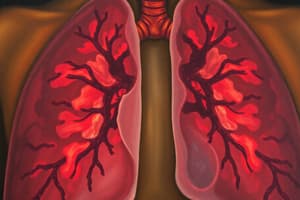Podcast
Questions and Answers
What is the primary characteristic that differentiates oncogenes from proto-oncogenes?
What is the primary characteristic that differentiates oncogenes from proto-oncogenes?
- Oncogenes have been mutated or overexpressed, leading to a gain of function. (correct)
- Oncogenes result from the inactivation of tumor suppressor genes.
- Oncogenes are involved in apoptosis while proto-oncogenes are not.
- Oncogenes are always present in all cells while proto-oncogenes are not.
Which mechanism can NOT convert proto-oncogenes into oncogenes?
Which mechanism can NOT convert proto-oncogenes into oncogenes?
- Gene Amplification
- Gene Suppression (correct)
- Point Mutations
- Chromosomal Rearrangement
What results from gene amplification in the context of proto-oncogenes?
What results from gene amplification in the context of proto-oncogenes?
- Hyperactive protein is made in normal amounts.
- Normal protein production is greatly increased. (correct)
- A loss of function mutation occurs.
- Normal protein production decreases.
Which type of mutation is associated with a dominant gain of function phenotype in oncogenes?
Which type of mutation is associated with a dominant gain of function phenotype in oncogenes?
What type of alteration can cause overproduction of a fusion protein related to a proto-oncogene?
What type of alteration can cause overproduction of a fusion protein related to a proto-oncogene?
What triggers cell proliferation as an example of a growth factor?
What triggers cell proliferation as an example of a growth factor?
What is the primary role of tumour suppressor genes?
What is the primary role of tumour suppressor genes?
How many mutations are generally required in tumour suppressor genes to promote cancer development, according to the two-hit hypothesis?
How many mutations are generally required in tumour suppressor genes to promote cancer development, according to the two-hit hypothesis?
In sporadic retinoblastoma cases, what percentage occurs without any family history?
In sporadic retinoblastoma cases, what percentage occurs without any family history?
Which of the following best describes the nature of mutations in familial cancers compared to sporadic cancers?
Which of the following best describes the nature of mutations in familial cancers compared to sporadic cancers?
What is a characteristic of the Ras protein in the context of cancer?
What is a characteristic of the Ras protein in the context of cancer?
Which of the following statements is false regarding the function of a tumour suppressor gene?
Which of the following statements is false regarding the function of a tumour suppressor gene?
What is true about germline mutations in relation to cancer?
What is true about germline mutations in relation to cancer?
In retinoblastoma, what does a mutation in the retinoblastoma (Rb) gene signify?
In retinoblastoma, what does a mutation in the retinoblastoma (Rb) gene signify?
Which statement best describes the role of proto-oncogenes in cancer?
Which statement best describes the role of proto-oncogenes in cancer?
How does age impact cancer incidence according to cancer statistics?
How does age impact cancer incidence according to cancer statistics?
What types of mutations are primarily associated with tumor suppressor genes?
What types of mutations are primarily associated with tumor suppressor genes?
What is the general requirement for the development of most cancers?
What is the general requirement for the development of most cancers?
Which of the following best categorizes mutations as carcinogens?
Which of the following best categorizes mutations as carcinogens?
In the context of cancer, what effect do tumor suppressor genes typically have?
In the context of cancer, what effect do tumor suppressor genes typically have?
Which of the following statements about cancer is accurate?
Which of the following statements about cancer is accurate?
Flashcards
Oncogene
Oncogene
A proto-oncogene that becomes activated due to mutation or overexpression, causing uncontrolled cell growth.
Proto-oncogene
Proto-oncogene
A normal gene involved in cell growth or division.
Gene Amplification
Gene Amplification
When a proto-oncogene is duplicated many times, creating extra copies of the gene and too much hyperactive protein.
Point Mutation
Point Mutation
Signup and view all the flashcards
Chromosomal Rearrangement
Chromosomal Rearrangement
Signup and view all the flashcards
Tumor Suppressor Gene
Tumor Suppressor Gene
Signup and view all the flashcards
Loss-of-Function Mutation
Loss-of-Function Mutation
Signup and view all the flashcards
Recessive (Mutation)
Recessive (Mutation)
Signup and view all the flashcards
Knudson's Two-Hit Hypothesis
Knudson's Two-Hit Hypothesis
Signup and view all the flashcards
Sporadic Cancer
Sporadic Cancer
Signup and view all the flashcards
Familial Cancer
Familial Cancer
Signup and view all the flashcards
Retinoblastoma
Retinoblastoma
Signup and view all the flashcards
Cancer: One disease or many?
Cancer: One disease or many?
Signup and view all the flashcards
Cancer's relationship with age
Cancer's relationship with age
Signup and view all the flashcards
What causes cancer?
What causes cancer?
Signup and view all the flashcards
Germline vs. Somatic mutations
Germline vs. Somatic mutations
Signup and view all the flashcards
Proto-oncogenes: The accelerator
Proto-oncogenes: The accelerator
Signup and view all the flashcards
Tumor suppressor genes: The brake
Tumor suppressor genes: The brake
Signup and view all the flashcards
Cancer-causing mutations: Gain-of-function
Cancer-causing mutations: Gain-of-function
Signup and view all the flashcards
Cancer-causing mutations: Loss-of-function
Cancer-causing mutations: Loss-of-function
Signup and view all the flashcards
Study Notes
Cancer Overview
- Cancer is a genetic disease, mainly affecting the elderly population.
- Cancer is characterized by uncontrolled cell division and the potential to invade surrounding tissues.
- Cancer incidence increases with age.
- Cancer development is a multi-stage process, with some cancers, like retinoblastoma, occurring in children.
- Cancer is caused by mutations in cellular genes—both oncogenes and tumor suppressor genes.
Cancer Statistics
- Approximately 385,477 new cancer cases occur annually in the UK (2017-2019 average)
- More than half of new cancer cases are breast, prostate, lung, or bowel cancer (2017-2019 average).
- The highest occurrence of cancer cases in the UK ranges from age 85 to 89 (2017-2019 average).
Cancer Types and Incidence
- Many different cancer types exist.
- The occurrence of cancer varies between different types and sexes.
Cancer and Age
- Cancer incidence increases with age, as more mutations accumulate in cells.
Proto-oncogenes
- Proto-oncogenes are normal cellular genes involved in cell growth and division.
- Mutations or overexpression of proto-oncogenes can transform them into oncogenes.
- Oncogenes drive uncontrolled cell proliferation.
Tumor Suppressor Genes
- Tumor suppressor genes prevent uncontrolled cell proliferation.
- These genes normally act as brakes on cell division.
- Mutations in tumor suppressor genes can cause them to lose their function, allowing cells to divide uncontrollably.
- An example of a tumor suppressor gene is p53. p53 regulates cell cycle, DNA repair, and apoptosis.
- Mutations in p53 are implicated in ~50% of human cancers (e.g., breast, lung, colorectal, stomach).
Two-Hit Hypothesis (Retinoblastoma)
- Retinoblastoma is a tumor of the retina that can occur both sporadically and hereditarily.
- The two-hit hypothesis explains how a tumor suppressor gene mutation (Rb gene) can lead to retinoblastoma.
- Sporadic retinoblastoma requires two somatic mutations in the Rb gene.
- Familial retinoblastoma occurs when one Rb mutation is inherited. The second mutation is somatic.
BRCA1 and BRCA2
- BRCA1 and BRCA2 are tumor suppressor genes crucial for normal DNA repair in cells.
- Mutations in BRCA1/2 increase significantly the risk of early-onset breast cancer. Mutations tend to reduce the ability of the proteins to repair DNA damage.
- Sporadic breast cancer occurs in older women, primarily with a single tumor appearing in a single breast.
- Familial breast cancer occurs in younger women and often has multiple tumors in both breasts.
- The proportion of hereditary breast cancer cases from BRCA1 mutations is 7%-10%.
Cell Cycle and Rb
- Rb is a tumor suppressor that acts as a "brake" during the G1/S checkpoint of the cell cycle. It prevents cells from dividing when conditions aren't suitable.
- Phosphorylation of Rb releases the brake.
- Non-phosphorylated Rb binds to and disables E2F transcription factors. Phosphorylation releases it, allowing cells to proceed through the cell cycle.
- Mutations can disrupt the cell cycle regulation and lead to tumor development.
Studying That Suits You
Use AI to generate personalized quizzes and flashcards to suit your learning preferences.





